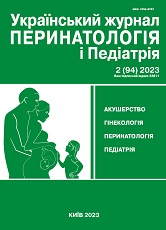Cytoreductive surgical treatment of giant metastasis of colorectal cancer in the ovary (clinical case)
DOI:
https://doi.org/10.15574/PP.2023.94.128Keywords:
colorectal adenocarcinoma, metastasis of colorectal cancer to the ovary, Krukenberg’s cancer, immunohistochemical study, expression of SC7, SC20, CDX2, cytoreductive surgeryAbstract
Purpose - to present and analyze the case of surgical treatment of a patient with secondary giant adenocarcinoma of the right ovary.
It is presented a clinical case of a giant metastasis of colorectal cancer to the ovary in a 48-year-old woman, measuring 30×20×15 cm, weighing about 9 kg, which occupied almost the entire volume of the abdominal cavity, pushing the stomach and intestines under the diaphragm with compression of the intestines, right ureter and the presence of ascites with a volume of 1.5 liters. A right-sided hemicolectomy with lymphodissection was performed, and an end-to-end ileotransversoanastmosis was applied. A right adnexectomy, extirpation of the uterus, omentectomy were performed.
During the immunohistochemical study, membrane-cytoplasmic expression of cytokeratin (CK) 20 and nuclear expression of CDX2 were revealed. CDX2 is a defining marker for the diagnosis of adenocarcinoma of the gastrointestinal tract, as well as for the differentiation of primary and metastatic ovarian carcinomas. The patient has a lack of expression of receptors for estrogen and CK7 and positive nuclear expression of CDX2, which indicates metastasis of colorectal adenocarcinoma to the ovary. According to the results of the histological examination, which were of decisive importance, the origin of the tumor was determined and, accordingly, the patient’s diagnosis - the tumor of the cecum is G2 adenocarcinoma with germination into the serous membrane, metastases to the right ovary and regional lymphatic nodes 10 out of 10, and areas of tumor growth in the mesentery.
Conclusions. In the case of detection of an ovarian neoplasm, the differential diagnosis of primary and secondary tumors is extremely important. Reproductive age at the time of presentation should not interfere with the diagnosis of primary or secondary ovarian malignancy. Metastases of primary colorectal cancer in the ovaries can manifest as pelvic tumors, so preoperative examination of the gastrointestinal tract and removal of the ovarian tumor with immunohistochemical examination is the leading option for choosing an appropriate treatment strategy. Immunohistochemical study of cytokeratin expression markers CK7, CK20 are appropriate for the differential diagnosis of synchronous cancer of the cecum and ovary, and CDX2 protein is a defining marker for the diagnosis of adenocarcinoma of the gastrointestinal tract and for distinguishing between primary and metastatic ovarian carcinomas. Cytoreductive surgery appears to be an important treatment option for metastatic ovarian neoplasia to improve prognosis. A multidisciplinary approach remains key in further examination, determination of the main diagnosis and development of an optimal treatment strategy.
The research was carried out in accordance with the principles of the Helsinki Declaration. The study protocol was approved by the Local Ethics Committee of all participating institutions. The informed consent of the patient was obtained for conducting the studies.
No conflict of interests was declared by the authors.
References
Bruchim I et al. (2013). Preoperative clinical and radiological features of metastatic ovarian tumors. Arch Gynecol Obstet. 288 (3): 615-619. https://doi.org/10.1007/s00404-013-2776-1; PMid:23471547
Choi HJ, Lee JH, Kang S, Seo SS, Choi JI, Lee S, Park SY. (2006, Sep). Contrast-enhanced CT for differentiation of ovarian metastasis from gastrointestinal tract cancer: stomach cancer versus colon cancer. AJR Am J Roentgenol. 187 (3): 741-745. https://doi.org/10.2214/AJR.05.0944; PMid:16928939
Fillmann SL, Fillmann HS et al. (2021, Apr-Jun). Ovarian Metastasis from Colorectal Adenocarcinoma. J. Coloproctol. (Rio J.). 41 (2). https://doi.org/10.1055/s-0041-1730426
Haikal A, Haikal C, Thiesfeldt S, Bou Zgheib N, Griswold D. (2020). Colorectal Carcinoma Presenting as Ovarian Metastasis: A Case Report. Archives of Clinical and Medical Case Reports. 4 (2): 273-279.
Kir G, Gurbuz A, Karateke A, Kir M. (2010, Apr 27). Clinicopathologic and immunohistochemical profile of ovarian metastases from colorectal carcinoma. World J Gastrointest Surg. 2 (4): 109-116. https://doi.org/10.4240/wjgs.v2.i4.109; PMid:21160859 PMCid:PMC2999225
Lee KC, Lin H, ChangChien CC et al. (2017). Difficulty in diagnosis and different prognoses between colorectal cancer with ovarian metastasis and advanced ovarian cancer: An empirical study of different surgical adoptions. Taiwan J Obstet Gynecol. 56 (1): 62-67. https://doi.org/10.1016/j.tjog.2015.02.009; PMid:28254228
Lee SJ, Bae JH, Lee AW, Tong SY, Park YG, Park JS. (2009, Feb). Clinical Characteristics of Metastatic Tumors to the Ovaries. J Korean Med Sci. 24 (1): 114-119. https://doi.org/10.3346/jkms.2009.24.1.114; PMid:19270823 PMCid:PMC2650975
Mori Y, Nyuya A, Yasui K, Toshima T, Kawai T, Taniguchi F et al. (2018, Mar 27). Clinical outcomes of women with ovarian metastases of colorectal cancer treated with oophorectomy with respect to their somatic mutation profiles. Oncotarget. 9 (23): 16477-16488. https://doi.org/10.18632/oncotarget.24735; PMid:29662660 PMCid:PMC5893255
Shimazaki J, Tabuchi T, Nishida K et al. (2016). Synchronous ovarian metastasis from colorectal cancer: A report of two cases. Oncol Lett. 12 (1): 257-261. https://doi.org/10.3892/ol.2016.4553; PMid:27347134 PMCid:PMC4906625
Zulfiqar M, Koen J, Nougaret S et al. (2020). Krukenberg Tumors: Update on Imaging and Clinical Features. American Journal of Roentgenology. 215: 1020-1029. https://doi.org/10.2214/AJR.19.22184; PMid:32755184
Downloads
Published
Issue
Section
License
Copyright (c) 2023 Ukrainian Journal of Perinatology and Pediatrics

This work is licensed under a Creative Commons Attribution-NonCommercial 4.0 International License.
The policy of the Journal “Ukrainian Journal of Perinatology and Pediatrics” is compatible with the vast majority of funders' of open access and self-archiving policies. The journal provides immediate open access route being convinced that everyone – not only scientists - can benefit from research results, and publishes articles exclusively under open access distribution, with a Creative Commons Attribution-Noncommercial 4.0 international license(СС BY-NC).
Authors transfer the copyright to the Journal “MODERN PEDIATRICS. UKRAINE” when the manuscript is accepted for publication. Authors declare that this manuscript has not been published nor is under simultaneous consideration for publication elsewhere. After publication, the articles become freely available on-line to the public.
Readers have the right to use, distribute, and reproduce articles in any medium, provided the articles and the journal are properly cited.
The use of published materials for commercial purposes is strongly prohibited.

